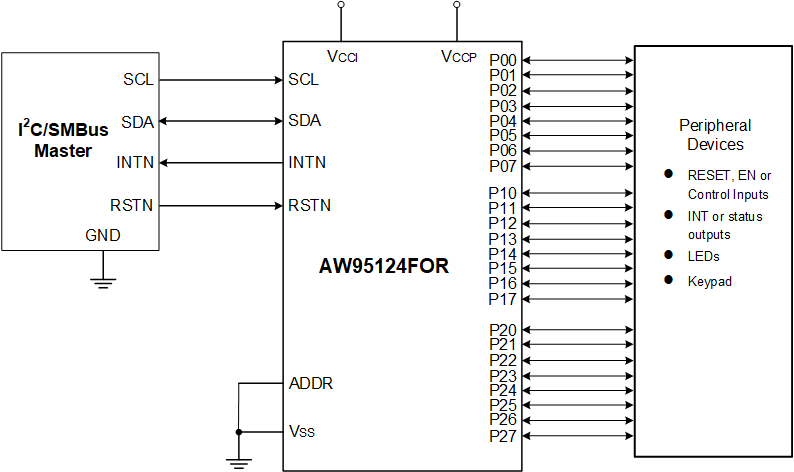| Channel |
24 |
| Addresses |
4 |
| Reset |
√ |
| Constant Current |
× |
| Pull-up |
√ |
| Level Shift |
√ |
| Temperature |
-40℃~105℃ |
| Power Supply (Min) (V) |
VCCI: 1.08
VCCP: 1.08 |
| Power Supply (Max) (V) |
VCCI: 3.6
VCCP: 3.6 |
| Package (mm) |
FOWLP 2.6X2.6-36B(0.56) |
1. I2C-bus to 24-bit parallel port expander
2. 1MHz I2C interface
3. power supply
1) VCCI: 1.08V~3.6V
2) VCCP: 1.08V~3.6V
4. Allows bidirectional voltage-level translation and GPIO expansion between 1.2V, 1.8V, 2.5V and 3.3V I2C bus and P ports
5. Low standby current consumption of 1.5μA (typical at 3.6V VCCI/VCCP)
6. Interrupts can be specified by level or edge(rising or falling) triggered
7. 3.6V tolerant I/O ports
8. Active LOW reset input (RSTN)
9. I2C software reset call
10. Open-drain active-low interrupt output (INTN)
11. Hardware address pin allows four devices on the same I2C, SMBus bus
12. Noise filter on SCL/SDA inputs
13. Latched outputs with high-current drive capability for directly driving LEDs
14. Operation temperature range: -40°C~105°C
15. Package: FOWLP 2.6X2.6-36B
AW95124 device provides general purpose parallel input/output (I/O) expansion for the two-line bidirectional I2C bus (or SMBus) protocol. The device can operate with a power supply voltage ranging from 1.08V to 3.6V on the I2C bus side (VCCI) and a power supply voltage ranging from 1.08V to 3.6V on the P port side (VCCP).AW95124 supports 100kHz, 400kHz, and 1MHz I2C clock frequencies.
AW95124 has Agile I/O plus ports which include additional features designed to enhance the I/O performance. The additional features are: maskable interrupt, latchable inputs, interrupt status register, programmable output drive strength, programmable pull-up and pull-down resistors, programmable open-drain or push-pull outputs, Interrupts can be specified by level or edge(rising or falling) triggered, and can be cleared individually without disturbing the other interrupt events. Also, switch debounce hardware is implemented.
The power-on reset puts the registers in their default state and initializes the I2C/SMBus state machine. The RSTN pin causes the same reset/initialization to occur without depowering the part. The system master can also accomplish a reset via an I2C command and initialize all registers to their default state.

